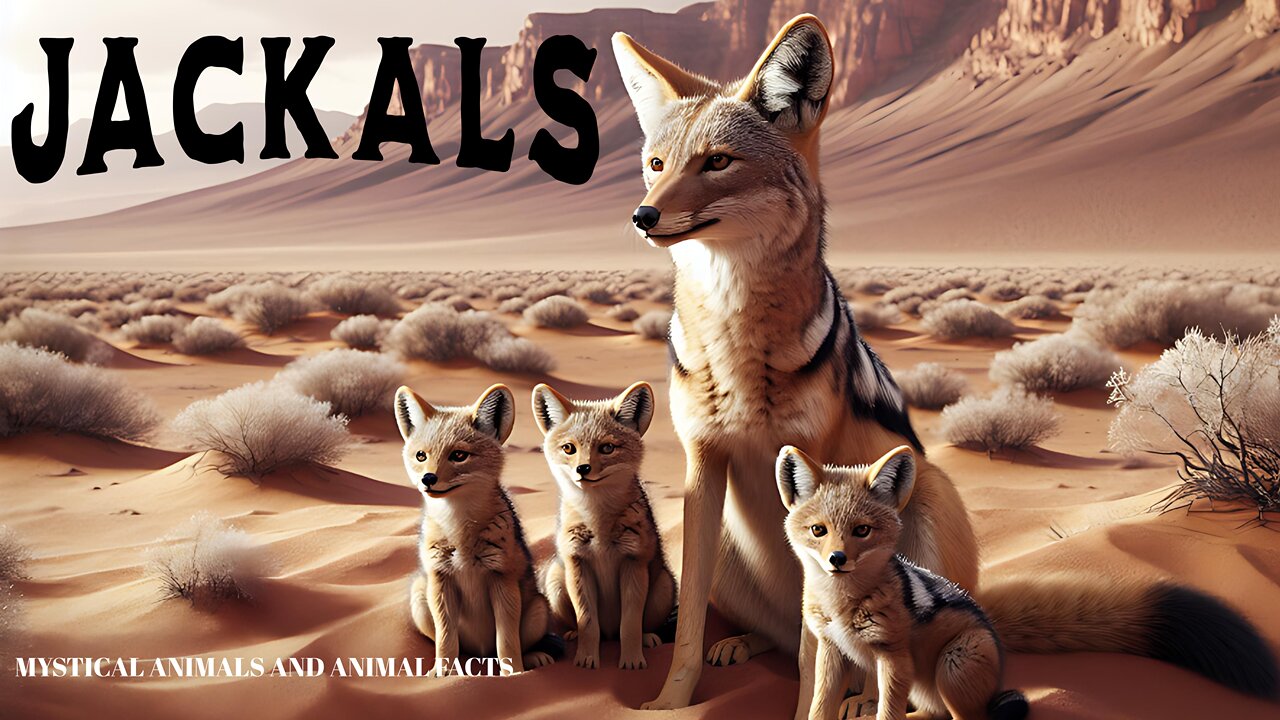Premium Only Content

Jackals: beautiful survivors - mini documentary
Shirts and more
Designs Redbubble
https://www.redbubble.com/people/ReneMM/shop?asc=u
Spreadshirt.at
https://www.spreadshirt.at/shop/user/renemm/?srEdit=pa#?affiliateId=1257693
Spreadshirt.com
https://www.spreadshirt.com/shop/user/renemm/?srEdit=pa#?affiliateId=11625
Shirtee.at
https://www.shirtee.com/de/catalogsearch/result/index/designer_id/112048/all_stores/
1/
Jackals are medium-sized canids that belong to the genus Canis and are found in various regions of Africa, Asia and south-east Europe. There are three main species: the golden jackal, the black-backed jackal and the striped jackal. Each species has specific morphological and ecological adaptations that enable them to survive in different habitats. Jackals are characterised by slender bodies, long legs and pointed snouts, although their coat colouring varies depending on the species and geographical location. The golden jackal has a golden-yellow to grey-brown coat, the black-backed jackal can be recognised by its black ‘saddle markings’ on the back, while the striped jackal is characterised by light stripes on its flanks. The average body length is 70-100 cm with a weight of 7-15 kg, with males tending to be larger and heavier than females. As generalists, jackals colonise a wide variety of habitats, including savannahs, semi-deserts, scrubland, forest edges and even agricultural areas. The golden jackal is the most widespread, occurring from south-east Europe to the Middle East and India, while the two African species are native to sub-Saharan Africa. Jackals are adaptable omnivores whose diet consists of small mammals, birds, insects, reptiles, fruit, carrion and human waste, depending on availability. Their hunting techniques include stalking, chasing and communal capture of prey, often acting in pairs or small family groups. As opportunistic scavengers, they play an important role in the ecosystem by removing carcasses and thus contributing to disease control.
Jackals are mainly crepuscular and nocturnal to avoid the heat of the day and competition with larger predators such as hyenas or lions. They mark territories with urine, faeces and secretions from scent glands, whereby the size of the territory varies between 2 and 20 square kilometres depending on the resources available. Socially, jackals usually live in monogamous pairs that stay together for life, or in small groups consisting of the parents and their offspring. Reproduction is seasonal, with females giving birth to 2-6 pups in underground burrows or abandoned animal dens after a gestation period of around 60 days. Both parents participate in the rearing of the young, which become independent after 6-8 months and are sexually mature at around one year of age. Communication includes a broad repertoire of sounds, including characteristic howls that serve to coordinate within the group or mark the territory. These howls are often heard at dusk and can be heard over long distances. Jackals are highly adaptable to landscapes modified by humans, which sometimes leads to conflicts as they occasionally prey on livestock such as poultry or young goats. At the same time, they benefit from the proximity to settlements, where they utilise waste or unattended food sources. In some regions they are therefore persecuted as pests, while in other cultures they are traditionally seen as a symbol of cunning or survival skills, albeit without the deep mythological roots of other canids such as wolves or foxes. Overall, the jackal population is considered stable, as their ecological flexibility protects them from serious population declines. Local threats can occur due to habitat loss, poaching or poisoning, especially in areas with intensive land use. The golden jackal has even expanded its range into Central Europe in recent decades, presumably favoured by milder winters and the retreats of wolves that displace competitors. Research suggests that jackals play a key role in the regulation of rodent populations and thus indirectly contribute to the health of agroecosystems.
Their behaviour towards conspecifics is mostly territorial, whereby fights are rare and threatening gestures such as growling or snarling are often sufficient to resolve conflicts. There is a clear hierarchy within the family, with the parents controlling the distribution of food and the activities of the young. Jackals are known for their stamina and can travel long distances in search of food, reaching speeds of up to 50 km/h. Their senses, especially smell and hearing, are highly developed to locate prey even in difficult conditions. Despite their adaptability, jackals are dependent on intact food webs, as an excess of carrion, for example due to excessive hunting or epidemics, can disrupt their balance between predator and scavenger roles. Their ability to survive in coexistence with humans makes them a fascinating example of ecological resilience, even if their image fluctuates between admiration for their survival skills and rejection due to livestock conflicts.
-
 1:33:41
1:33:41
Dinesh D'Souza
1 day agoThe Dragon's Prophecy Film
50K26 -
 15:10
15:10
Dr Disrespect
2 days agoI FINALLY Beat Baby Steps
122K16 -
 19:54
19:54
Forrest Galante
4 days agoPrivate Tour Of America's Best Marine Animal Facility
102K15 -
 LIVE
LIVE
Lofi Girl
2 years agoSynthwave Radio 🌌 - beats to chill/game to
251 watching -
 2:19:50
2:19:50
Akademiks
5 hours agoDrake Lawsuit Dismissed by Federal Judge. What does it Mean.... for the boy.
126K9 -
 1:01:38
1:01:38
DeVory Darkins
14 hours ago $48.77 earnedSchumer suffers humiliation as critics applaud Trump's historic peace deal with Tim Pool
110K57 -
 56:09
56:09
Steven Crowder
19 hours agoBlack Fatigue is Real and I Told Them Why | Black & White on the Gray Issues
518K2.21K -
 2:05:36
2:05:36
Inverted World Live
12 hours agoSaint's Tomb Opened for First Time in 800 Years for Ancient Ritual | Ep. 121
102K18 -
 2:43:30
2:43:30
TimcastIRL
9 hours agoNY AG Indicted For FRAUD, Faces 30 Years In Prison, $1 MILLION FINE | Timcast IRL
228K110 -
 1:09:16
1:09:16
Man in America
19 hours agomRNA 2.0: This Frightening Tech Can Target Your BRAIN Using Biological Post Codes
60.3K23